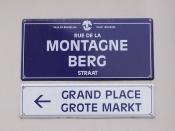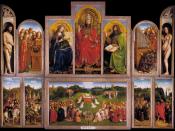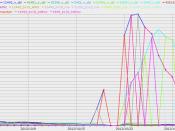Geographically and culturally, Belgium is at the crossroads of Europe. Belgium is located in Western Europe between France and the Netherlands. Belgium is one of Europe's true melting pots were Celtic, Roman, German, French, Dutch, Spanish, and Austrian cultures having made an imprint. Belgium got its name from a Celtic tribe, the Belgae, whom Caesar described as the most courageous tribe of Gaul. In about A.D. 300, Attila the Hun invaded what is now Germany and pushed Germanic tribes into northern Belgium. About 100 years later, the Germanic tribe of the Franks invaded and took possession of Belgium. The northern part of Belgium became a Germanized and Germanic- Frankish-speaking area, and in the southern part people continued to be Roman and spoke forma of Latin. Belgium was occupied by the Spanish (1519-1713) and the Austrians (1713-1794), and during this time Ghent, Bruges, Brussels, and Antwerp took turns at being major European centers for commerce, industry and art.
Flemish paintings became the most prized in Europe. Flemish tapestries hung on the walls of castles throughout Europe. After the French Revolution, Belgium was invaded and it was made a part of the Netherlands. In 1830, Belgium took its independence from the Dutch because of an uprising of the Belgian people. Leopold of Saxe-Coburg became their first King. Today, the Belgians are divided ethnically into the Dutch-speaking Flemings and French-speaking Walloons. Their current king is Albert II.
There are many industries in Belgium and they include: engineering and metal products, motor vehicle assembly, processed food and beverages, chemicals, basic metals, textiles, glass, petroleum, and coal. Belgium's natural resources are coal and natural gas. Though it isn't really an industry, Belgium is also known for its chocolates and waffles.
In Belgium, you will most likely find small animals, primarily foxes, badgers, pheasants, squirres, weasels,



Adequate
This was all right, but not great. Most of your sentences were coherent, but were structured in a way that your thoughts appeared to be blocky. Also, try not to use the word "Belgium" in nearly every one of your sentences; this makes your paper appear very repetitive. Redundancy seems to happen quite often in your paper, in which redundancy seems to be the main problem. "In Belgium, you will most likely find small animals, primarily foxes, badgers, pheasants, squirres, weasels, martens, and hedgehogs, are found in Belgium." Overall, not a bad paper, yet you seem to skip over the Flemish and the Walloons--who, if I'm not mistaken, are the two largest ethnic groups in Belgium.
1 out of 1 people found this comment useful.